Thekchen Chöling, Dharamsala, HP, India - It was a bright morning today as His Holiness the Dalai Lama was greeted at the gate to his residence by Ven Thuksey Rinpoché and others. He then drove in a golf cart to the foot of the Tsuglagkhang, the Main Tibetan Temple. The aisle up the middle of the courtyard was lined by monks and nuns who greeted him. His Holiness was escorted by monks playing horns and carrying a ceremonial umbrella. He rode in a lift up to the main floor and walked around the Kalachakra Temple and Tsuglagkhang before entering the Main Temple and taking his seat on the throne. Thuksey Rinpoché, who presided over the ceremony, offered a silk scarf by way of welcome.
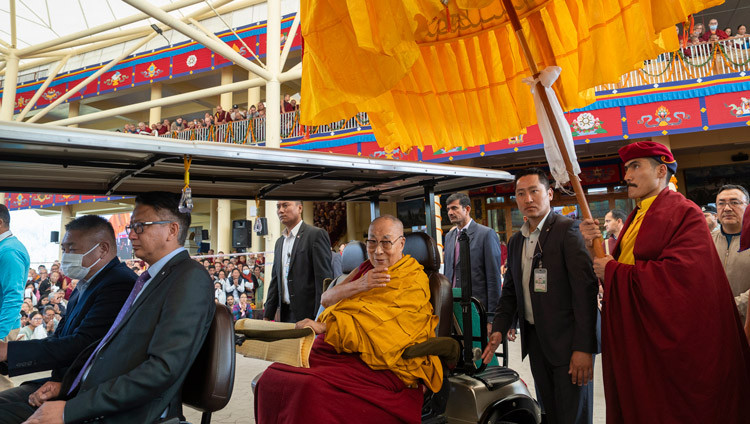
The ceremony offered today was based on an Amitayus ritual entitled ‘One Life, One Vase’. Among a gathering of an estimated 5000 people, the Drukpa Kagyu group of monks, nuns and tokdens—monks who spend their lives in meditation retreat—numbered just over 300. They sat in the middle of the temple. Members of the Tibetan Parliament-in-Exile sat down the side of the temple to His Holiness’s left, while Secretaries of the Central Tibetan Administration sat down the side to his right. Serving and former Kalöns sat to the left of the throne and to the right sat Trulshik Rinpoché, Gyutö Khensur, Segyu Khenpo, the Tashi Lhunpo Khenpo and the Drepung Loseling Khensur.
The ceremony began with the ‘Prayer of the Three Continuums’, the chanting led by a male and female chantmaster, who were supported by the steady rhythm of cymbals, horns and drums.
Tea and sweet rice were served to the gathering.
A table was set up in front of the throne on which were placed five ritual cakes coloured white, yellow, red, green and blue. Five monks dressed as dakinis (Skyfarers) entered the temple wearing elaborate silk brocade robes and five-leafed crowns. They gathered in front of the throne where they danced. The purpose of this part of the ceremony was to deflect the dakinis from their wish to take the Lama to their pure lands. After being offered verses and presented with a ritual cake that serves as kind of ransom, one by one, the dakinis circled the throne and left the temple.
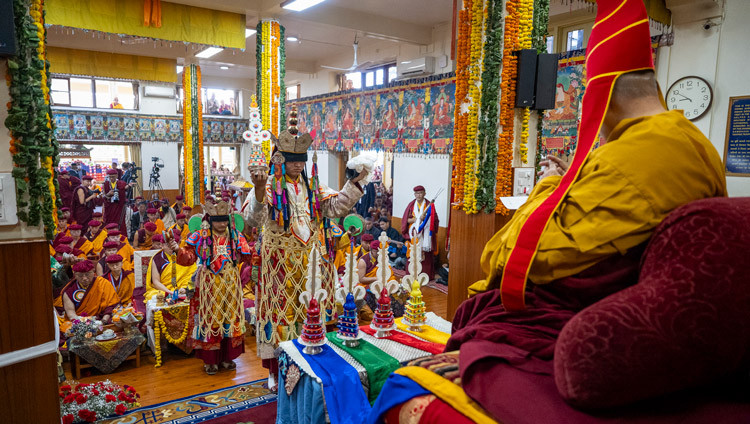
The prayers continued including such lines as, “Please bless the Lama to live long; May the Lama live for 100 aeons.” The Seven-limb Prayer from the Samantabhadra Prayer was recited. Thuksey Rinpoché came forward to present His Holiness with a red and blue hat like a beret that derives from an episode in the life of Tsangpa Gyaré who founded the Drukpa lineage. His Holiness put it on.
Thuksey Rinpoché, Tulku Sangyé Dorjé and Gyarawa Rinpoché made an offering of a large mandala to His Holiness, which was followed by offerings of representations of the body, speech and mind of the Buddha, a vajra, bell, damaru and phurba and other symbols. A procession of individuals bearing auspicious symbols, gifts of books, fabric, grain and so forth filed through the temple.
Prayers were made for His Holiness’s long life were made stating, “There is no other Pure Land like this, please remain here. There is no other throne like this, firm as Mt Meru, please remain here.”
As the ceremony came to an end Thuksey Rinpoché presented the Eight Auspicious Substances to His Holiness followed by long-life pills and the nectar of longevity. After requesting forbearance for any errors or ommissions, the virtue of the ritual was dedicated in order that all sentient beings may complete the two accumulations of merit and wisdom in order that they may achieve the bodies of a Buddha. There was a recitation of the ‘Prayer for the Flourishing of the Dharma’, which His Holiness composed.
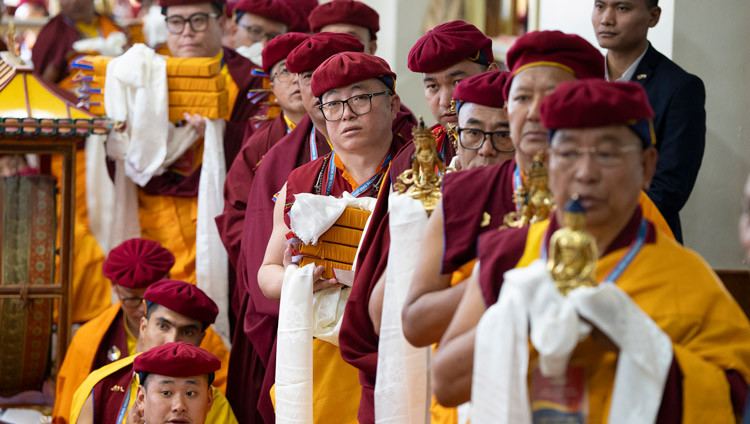
He addressed the assembly:
“Today, members of the Drukpa Kagyu have offered this Long-life Offering. As I was on my way here I felt glad and curiously elated to be attending this ceremony. You have been doing well serving the Buddhadharma so I felt happy to be here today. When we pray for the Dharma to flourish, it’s not about building monasteries and temples, it’s about our own practice, about gaining confidence in our practice. Practice isn’t about external developments. It involves studying the content of the Three Baskets, the Three Collections of Teachings, and the realization of that is what we mean by flourishing of the Dharma.
“I’ve studied, engaged in debate and employed logic. I’ve studied the Perfection of Wisdom, Middle View and so forth, under the guidance of my teachers. You too can study the Dharma and feel imbued with the teaching. It’ll make you feel happy. That’s how I’ve lived my life. You too can engage in the practice of the Three Trainings and, if you can also reflect on the meaning of emptiness until you get some kind of feeling for it, some sense of the taste of it, you will have peace of mind.
“Overcoming obstacles isn’t necessarily about something external to us. If you are able to take into account the practice of bodhichitta and emptiness, whatever difficulties you face, you won’t feel discouraged or despondent, your heart will be filled with joy.
“When it comes to preserving the Dharma, like the Indian masters who are known as the Six Ornaments and Two Supremes we are followers of the Dharma, followers of the Buddha himself. The Buddha’s enlightened activity, particularly his teaching, can be viewed from many angles. It’s vast and open not something narrow and limited.
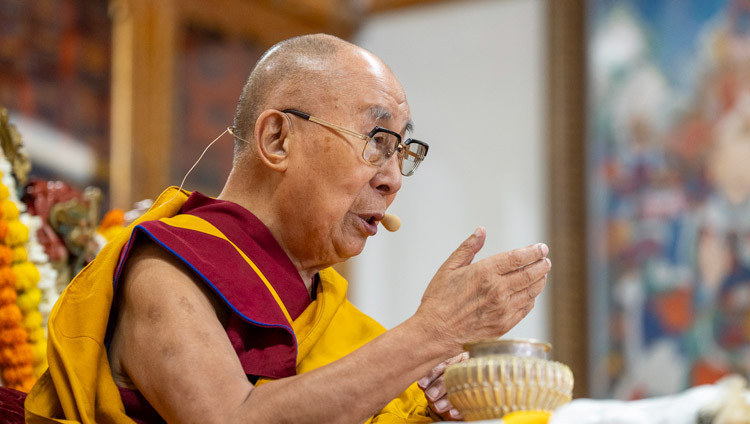
“When it comes to the ‘Treasury of Higher Knowledge” (Abhidharmakosha) and its description of cosmology, I don’t know what Vasubandhu would say if he were here today (and able to learn from science). However, I have memorized the ‘Ornament for Clear Realization’ (Abhisamayalankara), ‘Entering into the Middle View’ (Madhyamakavatara), the ‘Commentary on Valid Cognition’ (Pramanavartika). These books are very good, very useful, because of their critical analysis of the nature of things.
“When modern scientists take interest in the workings of the mind and emotions, they turn to us to learn about what we have to say about these things and they are appreciative. They are not interested in the religious aspect of the teachings of the Buddha, but in how Buddhist science explains the workings of the mind and emotions. We have significant and meaningful discussions.
“So, as followers of the Buddha, we too should learn about the mind and emotions. When the Buddha was alive, there was a fourfold Sangha. The entire community was suffused with calm and peace. If we can emulate that it will benefit us and be good for the Dharma as a whole. It will inspire others to be peaceful too.
“As a follower of the Buddha, as soon as I wake in the morning I meditate on the awakening mind of bodhichitta and the view of emptiness. I find this relaxing. It gives me peace of mind. And when I give teachings drawn from the Three Baskets, people appreciate it.
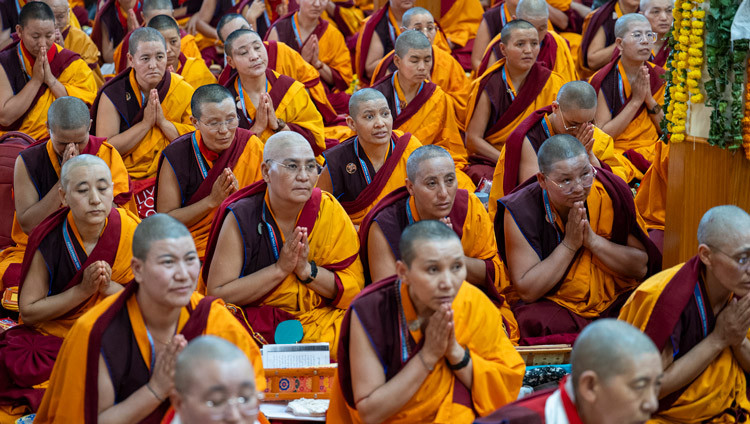
“Without talking about past and future lives, I try to tell people how to develop peace of mind in this world, here and now, by developing understanding of our minds and emotions—and many people appreciate that, especially modern scientists such as neuroscientists and psychologists.
“When it comes to the Dharma, you should study and learn about the teachings then develop experience of what you’ve learned within yourself so you can then share it with others.” A ripple of applause ran through the temple.
“I thank the Drukpa Kagyu for offering these prayers for my long life. I do my best with a sincere heart to benefit others. Of course, when we make prayers, with a sincere heart and dedication to the well-being of others, they will bear fruit.”












